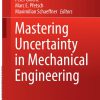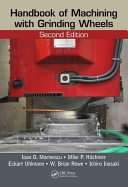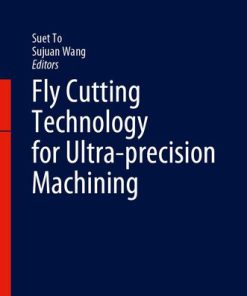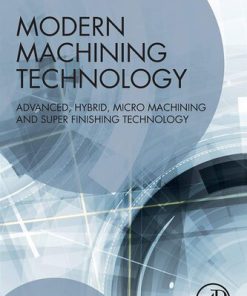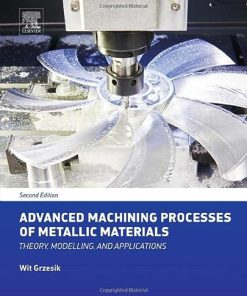Machining Technology and Operations 2nd Edition by Helmi Youssef, Hassan El Hofy 0367431319 9780367431310
$50.00 Original price was: $50.00.$25.00Current price is: $25.00.
Machining Technology and Operations 2nd Edition by Helmi Youssef, Hassan El Hofy – Ebook PDF Instant Download/Delivery: 0367431319, 9780367431310
Full download Machining Technology and Operations 2nd Edition after payment
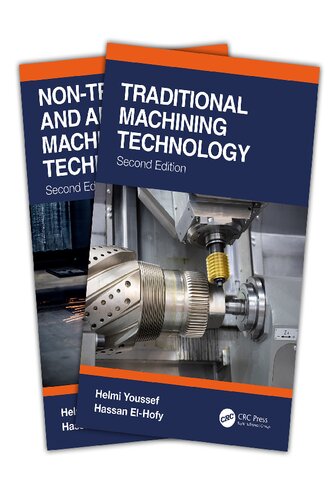
Product details:
ISBN 10: 0367431319
ISBN 13: 9780367431310
Author: Helmi Youssef; Hassan El-Hofy
This two-volume set addresses both current and developing topics of advanced machining technologies and machine tools used in industry. The treatments are aimed at motiving and challenging the reader to explore viable solutions to a variety of questions regarding product design and optimum selection of machining operations for a given task. This two-volume set will be useful to professionals, students, and companies in the areas of mechanical, industrial, manufacturing, materials, and production engineering fields. Traditional Machining Technology covers the technologies, machine tools, and operations of traditional machining processes. These include the general-purpose machine tools used for turning, drilling, and reaming, shaping and planing, milling, grinding and finishing operations. Thread and gear cutting, and broaching processes are included along with semi-automatic, automatic, NC and CNC machine tools, operations, tooling, mechanisms, accessories, jigs and fixtures, and machine tool dynamometry are discussed. Non-Traditional and Advanced Machining Technologies covers the technologies, machine tools, and operations of non-traditional mechanical, chemical and thermal machining processes. Assisted machining technologies, machining of difficult-to-cut materials, design for machining, accuracy and surface integrity of machined parts, environment-friendly machine tools and operations, and hexapods are also presented. The topics covered throughout this volume reflect the rapid and significant advances that have occurred in various areas in machining technologies.
Machining Technology and Operations 2nd Table of contents:
Chapter 1 Machining Technology
1.1 Introduction
1.2 History of Machine Tools
1.3 Basic Motions in Machine Tools
1.4 Aspects of Machining Technology
1.4.1 Machine Tool
1.4.2 Workpiece Material
1.4.3 Machining Productivity
1.4.4 Accuracy and Surface Integrity
1.4.5 Product Design for Economical Machining
1.4.6 Environmental Impacts of Machining
1.5 Review Questions
References
Chapter 2 Basic Elements and Mechanisms of Machine Tools
2.1 Introduction
2.2 Machine Tool Structures
2.2.1 Light- and Heavy-weight Constructions
2.3 Machine-Tool Guideways
2.3.1 Sliding Friction Guideways
2.3.2 Rolling Friction Guideways
2.3.3 Externally Pressurized Guideways
2.4 Machine-Tool Spindles
2.4.1 Spindle Bearings
2.4.2 Selection of Spindle-Bearing Fit
2.4.3 Sliding Friction Spindle Bearing
2.5 Machine Tool Drives
2.5.1 Stepped Speed Drives
2.5.1.1 Belting
2.5.1.2 Pick-Off Gears
2.5.1.3 Gearboxes
2.5.1.4 Stepping of Speeds According to Arithmetic Progression
2.5.1.5 Stepping of Speeds According to Geometric Progression
2.5.1.6 Kinetic Calculations of Speed Gearboxes
2.5.1.7 Application of Pole-Changing Induction Motors
2.5.1.8 Feed Gearboxes
2.5.1.9 Preselection of Feeds and Speeds
2.5.2 Stepless Speed Drives
2.5.2.1 Mechanical Stepless Drives
2.5.2.2 Electrical Stepless Speed Drive
2.5.2.3 Hydraulic Stepless Speed Drive
2.6 Planetary Transmission
2.7 Machine-Tool Motors
2.8 Reversing Mechanisms
2.9 Couplings and Brakes
2.10 Reciprocating Mechanisms
2.10.1 Quick-Return Mechanism
2.10.2 Whitworth Mechanism
2.10.3 Hydraulic Reciprocating Mechanism
2.11 Material Selection and Heat Treatment of Machine-Tool Components
2.11.1 Cast Iron
2.11.2 Steels
2.12 Testing of Machine Tools
2.13 Maintenance of Machine Tools
2.13.1 Preventive Maintenance
2.13.2 Corrective Maintenance
2.13.3 Reconditioning
2.14 Review Questions
References
Chapter 3 General-Purpose Metal-Cutting Machine Tools
3.1 Introduction
3.2 Lathe Machines and Operations
3.2.1 Turning Operations
3.2.2 Metal-Cutting Lathes
3.2.2.1 Universal Engine Lathes
3.2.2.2 Other Types of General-Purpose Metal-Cutting Lathes
3.3 Drilling Machines and Operations
3.3.1 Drilling and Drilling-Allied Operations
3.3.1.1 Drilling Operation
3.3.1.2 Drilling-Allied Operations
3.3.2 General-Purpose Drilling Machines
3.3.2.1 Bench-Type Sensitive Drill Presses
3.3.2.2 Upright Drill Presses
3.3.2.3 Radial Drilling Machines
3.3.2.4 Multispindle Drilling Machines
3.3.2.5 Horizontal Drilling Machines for Drilling Deep Holes
3.3.3 Tool-Holding Accessories of Drilling Machines
3.3.4 Work-Holding Devices Used on Drilling Machines
3.4 Milling Machines and Operations
3.4.1 Milling Operations
3.4.1.1 Peripheral Milling
3.4.1.2 Face Milling
3.4.2 Milling Cutters
3.4.3 General-Purpose Milling Machines
3.4.3.1 Knee-Type Milling Machines
3.4.3.2 Vertical Bed-Type Milling Machines
3.4.3.3 Planer-Type Milling Machines
3.4.3.4 Rotary-Table Milling Machines
3.4.4 Holding Cutters and Workpieces on Milling Machines
3.4.4.1 Cutter Mounting
3.4.4.2 Workpiece Fixturing
3.4.5 Dividing Heads
3.4.5.1 Universal Dividing Heads
3.4.5.2 Modes of Indexing
3.5 Shapers, Planers, and Slotters and Their Operations
3.5.1 Shaping, Planing, and Slotting Processes.
3.5.1.1 Determination of vcm in Accordance with the Machine Mechanism
3.5.2 Shaper and Planer Tools
3.5.3 Shapers, Planers, and Slotters
3.5.3.1 Shapers
3.5.3.2 Planers
3.5.3.3 Slotters
3.6 Boring Machines and Operations
3.6.1 Boring
3.6.2 Boring Tools
3.6.2.1 Types of Boring Tools
3.6.2.2 Materials of Boring Tools
3.6.3 Boring Machines
3.6.3.1 General-Purpose Boring Machines
3.6.3.2 Jig-Boring Machines
3.7 Broaching Machines and Operations
3.7.1 Broaching
3.7.1.1 Advantages and Limitations of Broaching
3.7.2 The Broach Tool
3.7.2.1 Tool Geometry and Configuration
3.7.2.2 Broach Material
3.7.2.3 Broach Sharpening
3.7.3 Broaching Machines
3.7.3.1 Horizontal Broaching Machines
3.7.3.2 Vertical Broaching Machines
3.7.3.3 Continuous Horizontal Surface Broaching Machines
3.8 Review Questions
References
Chapter 4 General-Purpose Abrasive Machine Tools
4.1 Grinding Machines and Operations
4.1.1 Grinding Process
4.1.2 Grinding Wheels
4.1.2.1 Manufacturing Characteristics of Grinding Wheels
4.1.2.2 Grinding Wheel Geometry
4.1.2.3 Mounting and Balancing of Grinding Wheels and Safety Measures
4.1.2.4 Truing and Dressing of Grinding Wheels
4.1.3 Grinding Machines
4.1.3.1 Surface-Grinding Machines and Related Operations
4.1.3.2 External Cylindrical Grinding Machines and Related Operations
4.1.3.3 Internal Grinding Machines and Related Operations
4.1.3.4 Centerless Grinding Machines and Related Operations
4.2 Microfinishing Machines and Operations
4.2.1 Honing
4.2.1.1 Process Capabilities
4.2.1.2 Machining Parameters
4.2.1.3 Honing Machines
4.2.2 Superfinishing (Microhoning)
4.2.2.1 Machining Parameters
4.2.3 Lapping
4.2.3.1 Machining Parameters
4.2.3.2 Lapping Machines
4.3 Review Questions
References
Chapter 5 Thread-Cutting Machines and Operations
5.1 Introduction
5.2 Thread Cutting
5.2.1 Cutting Threads on the Lathe
5.2.2 Thread Chasing
5.2.3 Thread Tapping
5.2.4 Die Threading
5.2.4.1 Die-Threading Machines
5.2.4.2 Die-Threading Performance
5.2.5 Thread Milling
5.2.5.1 Thread-Milling Machines
5.2.6 Thread Broaching
5.3 Thread Grinding
5.3.1 Center-Type Thread Grinding
5.3.2 Centerless Thread Grinding
5.4 Review Questions
References
Chapter 6 Gear-Cutting Machines and Operations
6.1 Introduction
6.2 Forming and Generating Methods in Gear Cutting
6.2.1 Gear Cutting by Forming
6.2.1.1 Gear Milling
6.2.1.2 Gear Broaching
6.2.1.3 Gear Forming by a Multiple-Tool Shaping Head
6.2.1.4 Straight Bevel Gear Forming Methods
6.2.2 Gear Cutting by Generation
6.2.2.1 Gear Hobbing
6.2.2.2 Gear Shaping with Pinion Cutter
6.2.2.3 Gear Shaping with Rack Cutter
6.2.2.4 Cutting Straight Bevel Gears by Generation
6.3 Selection of Gear-Cutting Method
6.4 Gear Finishing Operations
6.4.1 Finishing Gears Prior to Hardening
6.4.1.1 Gear Shaving
6.4.1.2 Gear Burnishing
6.4.2 Finishing Gears after Hardening
6.4.2.1 Gear Grinding
6.4.3 Gear Lapping
6.5 Review Questions and Problems
References
Chapter 7 Turret and Capstan Lathes
7.1 Introduction
7.2 Difference between Capstan and Turret Lathes
7.3 Selection and Application of Capstan and Turret Lathes
7.4 Principal Elements of Capstan and Turret Lathes
7.4.1 Headstock and Spindle Assembly
7.4.2 Carriage/Cross-Slide Unit
7.4.3 Hexagonal Turret
7.4.3.1 Manually Controlled Machines
7.4.3.2 Automatically Controlled Headstock Turret Lathes
7.4.4 Cross-Sliding Hexagonal Turret
7.5 Turret Tooling Setups
7.5.1 Job Analysis
7.5.2 Tooling Layout
7.6 Review Questions
References
Chapter 8 Automated Lathes
8.1 Introduction
8.2 Degree of Automation and Production Capacity
8.3 Classification of Automated Lathes
8.4 Semiautomatic Lathes
8.4.1 Single-Spindle Semiautomatics
8.4.2 Multispindle Semiautomatics
8.5 Fully Automatic Lathes
8.5.1 Single-Spindle Automatic
8.5.1.1 Turret Automatic Screw Machine
8.5.1.2 Swiss-Type Automatic
8.5.2 Horizontal Multispindle Bar and Chucking Automatics
8.5.2.1 Special Features of Multispindle Automatics
8.5.2.2 Characteristics of Parallel- and Progressive-Action Multispindle Automatic
8.5.2.3 Operation Principles and Constructional Features of a Progressive Multispindle Automatic
8.6 Design and Layout of Cams for Fully Automatics
8.6.1 Tooling Layout and Establishing a Sequence of Operation
8.6.2 Cam Design
8.6.3 Illustrative Examples on Cam Design and Tooling Layout for Single- and Multi-Spindle Automatic
8.7 Review Questions and Problems
References
Chapter 9 Numerical Control and Computer Numerical Control
9.1 Introduction
9.2 Coordinate System
9.2.1 Machine-Tool Axes for NC
9.2.2 Quadrant Notation
9.2.3 Point Location
9.2.4 Zero Point Location
9.2.5 Setup Point
9.2.6 Absolute and Incremental Positioning
9.3 Machine Movements In Numerical Control Systems
9.4 Interpolation
9.5 Control of Numerical Control Machine Tools
9.6 Components of Numerical Control Machine Tools
9.7 Tooling for Numerical Control Machines
9.8 Types of Numerical Control Machine Tools
9.9 Input Units
9.10 Forms of Numerical Control Instructions
9.11 Program Format
9.12 Feed and Spindle Speed Coding
9.12.1 Feed Rate Coding
9.12.2 Spindle Speed Coding
9.13 Features of Numerical Control Systems
9.14 Part Programming
9.15 Programming Machining Centers
9.15.1 Planning the Program
9.15.2 Canned Cycles
9.16 Programming Turning Centers
9.16.1 Planning the Program
9.16.2 Canned Turning Cycles
9.17 Computer-Assisted Part Programming
9.17.1 Automatically Programmed Tools Language
9.17.2 Programming Stages
9.18 CAD/CAM Approach to Part Programming
9.18.1 Computer-Aided Design
9.18.2 Computer-Aided Manufacturing
9.18.2.1 Postprocessor
9.18.2.2 Simulation
9.18.2.3 Download the CNC Programs
9.19 Review Questions
References
Chapter 10 Automated Manufacturing Systems
10.1 Introduction
10.2 Manufacturing Systems
10.3 Flexible Automation–Flexible Manufacturing Systems
10.3.1 Elements of Flexible Manufacturing System
10.3.2 Limitations of Flexible Manufacturing System
10.3.3 Features and Characteristics
10.3.4 New Developments in Flexible Manufacturing System Technology
10.4 Computer-Integrated Manufacturing
10.4.1 Computer-Aided Design
10.4.2 Computer-Aided Process Planning
10.4.3 Computer-Aided Manufacturing
10.5 Lean Production—Just-in-Time Manufacturing Systems
10.5.1 Steps for Implementing the IMPS Lean Production
10.5.2 Just-in-Time and Just-in-Case Production
Advantages of Just-in-Time
10.6 Adaptive Control
10.6.1 Integration of AC into CAD/CAM/CIM Systems
10.7 Smart Manufacturing and Artificial Intelligence
10.7.1 Expert Systems
10.7.2 Machine Vision
10.7.3 Artificial Neural Networks
10.7.4 Natural-Language Systems
10.7.5 Fuzzy Logic (Fuzzy Models)
10.8 Factory of the Future
10.9 Concluding Remarks Related to Automated Manufacturing
10.10 Review Questions
References
Chapter 11 Machine-Tool Dynamometers
11.1 Introduction
11.2 Design Features and Requirements
11.2.1 Rapier Parameters for Dynamometer Design
11.2.2 Main Requirements of a Good Dynamometer
11.3 Dynamometers Based On Displacement Measurements
11.3.1 Two-Channel Cantilever (Chisholm) Dynamometer
11.3.2 Two-Channel Slotted Cantilever Dynamometer
11.4 Dynamometers Based on Strain Measurement
11.4.1 Strain Gauges and Wheatstone Bridges
11.4.2 Cantilever Strain Gauge Dynamometers
11.4.3 Octagonal Ring Dynamometers
11.4.3.1 Strain Rings and Octagonal Ring Transducers
11.4.3.2 Turning Dynamometer
11.4.3.3 Surface Plunge-Cut Grinding Dynamometer
11.4.3.4 Milling Dynamometers
11.5 Piezoelectric (Quartz) Dynamometers
11.5.1 Principles and Features
11.5.2 Typical Piezoelectric Dynamometers
11.6 Review Questions
References
Index
Volume 02
Cover
Half Title
Title Page
Copyright Page
Dedication
Table of Contents
Preface
Acknowledgements
Author Biographies
List of Symbols
List of Acronyms
Unit I Non-Traditional Machining Operations and Non-Traditional Machine Tools
Chapter 1 Non-Traditional Machining Processes
1.1 Introduction
1.2 Classification of Non-Traditional Machining Processes
1.3 Review Questions
References
Chapter 2 Mechanical Non-Traditional Machining Operations and Machine Tools
2.1 Jet Machines and Operations
2.1.1 Abrasive Jet Machining
2.1.1.1 Process Characteristics and Applications
2.1.1.2 Work Station of Abrasive Jet Machining
2.1.1.3 Process Capabilities
2.1.2 Water Jet Machining (Hydrodynamic Machining)
2.1.2.1 Process Characteristics and Applications
2.1.2.2 Equipment of WJM
2.1.2.3 Process Capabilities
2.1.3 Abrasive Water Jet Machining
2.1.3.1 Process Characteristics and Applications
2.1.3.2 AWJM Equipment
2.1.3.3 Process Capabilities
2.2 Ultrasonic Machining
2.2.1 Definition, Characteristics, and Applications
2.2.2 USM Equipment
2.2.3 Design of Acoustic Horns
2.2.4 Process Capabilities
2.2.5 Recent Developments
2.3 Abrasive Flow Machining
2.3.1 Principles
2.3.2 Process Parameters of Abrasive Flow Machining
2.3.3 Applications of AFM
2.4 Review Questions and Problems
References
Chapter 3 Chemical and Electrochemical Non-Traditional Machining Operations and Machine Tools
3.1 Chemical Machining
3.1.1 Chemical Milling
3.1.2 Photochemical Machining (Spray Etching)
3.2 Electrochemical Machines and Operations
3.2.1 Process Characteristics and Applications
3.2.2 Elements of ECM
3.2.3 ECM Equipment (EC Sinking Machine)
3.2.4 Process Capabilities
3.2.5 ECM Allied Processes
3.2.5.1 Shaped Tube Electrolytic Machining
3.2.5.2 Electrostream (Capillary) Drilling
3.2.5.3 Electrochemical Jet Drilling
3.2.5.4 Electrochemical Deburring
3.2.5.5 Electrochemical Polishing
3.2.5.6 Electrochemical Sharpening
3.2.5.7 Electrochemical Grinding
3.2.5.8 Electrochemical Honing
3.3 Review Questions and Problems
References
Chapter 4 Thermo-Electrical Non-Traditional Machining Operations and Machine Tools
4.1 Electrical Discharge Machines and Operations
4.1.1 Process Characteristics and Applications
4.1.2 Sinking Machine
4.1.3 EDM-Spark Circuits (Power Supply Circuits)
4.1.3.1 Resistance-Capacitance RC Circuit
4.1.3.2 Transistorized Pulse Generator Circuits
4.1.4 EDM Tool Electrodes
4.1.5 Process Capabilities
4.1.6 EDM Allied Processes
4.1.6.1 Electrical Discharge Milling (ED Milling)
4.1.6.2 Electrical Discharge Wire Cutting
4.2 Electron Beam Machining Equipment and Operations
4.2.1 Process Characteristics and Applications
4.2.2 Electron Beam Machining Equipment
4.2.3 Process Capabilities
4.3 Laser Beam Machining Equipment and Operations
4.3.1 Process Characteristics
4.3.2 Types of Lasers
4.3.2.1 Pyrolithic and Photolithic Lasers
4.3.2.2 Industrial Lasers
4.3.3 Laser Beam Machining Operations
4.3.4 LBM Equipment
4.3.5 Applications and Capabilities
4.4 Plasma Arc Cutting Systems and Operations
4.4.1 Process Characteristics
4.4.2 Plasma Arc Cutting Systems
4.4.3 Applications and Capabilities of PAC
4.5 Review Questions and Problems
References
Unit II Advanced Machining Technology
Chapter 5 Machining of DTC Materials (Stainless Steels and Super Alloys) by Traditional and
5.1 Introduction
5.2 Traditional Machining of Stainless Steels
5.2.1 Types, Characteristics, and Applications of SSs
5.2.2 Machinability and Machinability Ratings of SSs
5.2.2.1 Free-Machining Additives of Stainless Steels
5.2.2.2 Machinability of Free- and Non-Free-Machining Stainless Steels
5.2.2.3 Enhanced Machining Stainless Steels
5.2.2.4 Machinability Ratings of Stainless Steels
5.2.3 Machining and Machining Conditions of SSs
5.3 Traditional Machining of Super Alloys
5.3.1 Types, Characteristics, and Applications of SAs
5.3.2 Machinability and Machinability Rating of Super Alloys
5.3.2.1 Machinability Aspects of Super Alloys
5.3.2.2 Machinability Rating of Super Alloys
5.3.3 Machining and Machining Conditions of Super Alloys
5.4 Non-Traditional Machining of Stainless Steels and Super Alloys
5.4.1 Machining of Stainless Steels and Super Alloys by Mechanical Techniques
5.4.2 Machining SSs and SAs by Electrochemical and Chemical Techniques
5.4.3 Thermoelectric Machining of Stainless Steels and Super Alloys
5.5 Review Questions
References
Chapter 6 Machining of DTC Materials (Ceramics and Composites) by Traditional and Non-Traditional Me
6.1 Introduction
6.2 Machining of Ceramic Materials
6.2.1 Ceramic as a Promising Engineering Material
6.2.2 Types, Characteristics, Classification, and Applications of Ceramics
6.2.2.1 Types, Characteristics, and Classification
6.2.2.2 Fields of Applications
6.2.3 Fabrication Techniques of Crystalline Ceramics
6.2.3.1 Processing Techniques and Shaping of Green Bodies
6.2.3.2 Green Machining Processes of Green and Pre-Sintered Ceramics
6.2.3.3 Hard Machining Processes of Sintered Ceramics
6.3 Machining of Composite Materials
6.3.1 Types, Characteristics, and Applications of Composites
6.3.2 Traditional Machining and Machinability of Composites
6.3.3 Non-Traditional Machining and Machinability of Composites
6.4 Review Questions
References
Chapter 7 Assisted Machining Technologies
7.1 Introduction
7.2 Thermal-Assisted Machining
7.2.1 Laser-Assisted Machining
7.2.2 Plasma-Assisted Machining
7.3 Vibration-Assisted Machining (VAM)
7.3.1 Principles and Aims of VAM
7.3.2 Vibration-Assisted Traditional Machining Processes
7.3.2.1 Vibration-Assisted Turning
7.3.2.2 Vibration-Assisted Drilling
7.3.2.3 Vibration-Assisted Milling
7.3.2.4 Vibration-Assisted Grinding
7.3.3 Vibration-Assisted Non-Traditional Machining Processes
7.3.3.1 Vibration-Assisted Electrochemical Machining (VAECM)
7.3.3.2 Vibration-Assisted Electrodischarge Machining
7.3.3.3 Vibration-Assisted Laser Beam Machining
7.3.3.4 Vibration-Assisted Abrasive Water Jet Machining
7.4 Magnetic Field-Assisted Processes
7.4.1 Magnetic Abrasive Finishing (MAF)
7.4.1.1 Finishing of Outer Cylindrical Surfaces and Typical Machining Conditions of MAF
7.4.1.2 MAF Finishing of Inner Cylindrical Surfaces
7.4.1.3 Semi-Magnetic Abrasive Finishing (SMAF)
7.4.1.4 Other MAF Applications
7.4.2 Magnetic Float Polishing (MFP) or Magnetic Fluid Grinding (MFG)
7.4.3 Advantages of MFAP
7.4.4 Magnetorheological Finishing (MRF)
7.4.5 Magnetorheological Abrasive Flow Finishing (MRAFF)
7.5 Review Questions
References
Chapter 8 Design for Machining
8.1 Introduction
8.1.1 General Design Rules
8.2 General Design Recommendations
8.3 Design for Machining by Cutting
8.3.1 Turning
8.3.1.1 Economic Production Quantities
8.3.1.2 Design Recommendations for Turning
8.3.1.3 Dimensional Control
8.3.2 Drilling and Allied Operations
8.3.2.1 Economic Production Quantities
8.3.2.2 Design Recommendations for Drilling and Allied Operations
8.3.2.3 Dimensional Control
8.3.3 Milling
8.3.3.1 Design Recommendations
8.3.3.2 Dimensional Factors and Tolerances
8.3.4 Shaping, Planing, and Slotting
8.3.4.1 Design Recommendations
8.3.4.2 Dimensional Control
8.3.5 Broaching
8.3.5.1 Design Recommendations
8.3.5.2 Dimensional Factors
8.3.5.3 Recommended Tolerances
8.3.6 Thread Cutting
8.3.6.1 Design Recommendations
8.3.6.2 Dimensional Factors and Tolerances
8.3.7 Gear Cutting
8.3.7.1 Design Recommendations
8.3.7.2 Dimensional Factors
8.4 Design for Grinding
8.4.1 Surface Grinding
8.4.1.1 Design Recommendations
8.4.1.2 Dimensional Control
8.4.2 Cylindrical Grinding
8.4.2.1 Design Recommendations
8.4.2.2 Dimensional Factors
8.4.3 Centerless Grinding
8.4.3.1 Design Recommendations
8.4.3.2 Dimensional Control
8.5 Design for Abrasive Finishing Processes
8.5.1 Honing
8.5.2 Lapping
8.5.3 Superfinishing
8.6 Design for Chemical and Electrochemical Machining
8.6.1 Chemical Machining
8.6.1.1 Design Recommendations
8.6.1.2 Dimensional Factors and Tolerances
8.6.2 Electrochemical Machining
8.6.2.1 Design Recommendations
8.6.2.2 Dimensional Factors
8.6.3 Electrochemical Grinding
8.6.3.1 Design Recommendations
8.6.3.2 Dimensional Factors
8.7 Design for Thermal Machining
8.7.1 Electrodischarge Machining
8.7.1.1 Design Recommendations
8.7.1.2 Dimensional Factors
8.7.2 Electron Beam Machining
8.7.3 Laser Beam Machining
8.8 Design for Ultrasonic Machining
8.9 Design for Abrasive Jet Machining
8.10 Review Questions
References
Chapter 9 Accuracy and Surface Integrity Realized by Machining Processes
9.1 Introduction
9.2 Surface Texture
9.3 Surface Quality and Functional Properties
9.4 Surface Integrity
9.5 Surface Effects by Traditional Machining
9.5.1 Chip Removal Processes
9.5.2 Grinding
9.6 Surface Effects by Non-Traditional Machining
9.6.1 Electrochemical and Chemical Machining
9.6.2 Thermal Non-Traditional Processes
9.6.2.1 Electrodischarge Machining
9.6.2.2 Laser Beam Machining
9.6.2.3 Electron Beam Machining
9.6.2.4 Plasma Beam Machining (PBM)
9.6.2.5 Electroerosion Dissolution Machining
9.6.2.6 Electrochemical Discharge Grinding
9.6.3 Mechanical Non-Traditional Processes
9.7 Reducing Distortion and Surface Effects in Machining
9.8 Review Questions
References
Chapter 10 Environment-Friendly Machine Tools and Operations
10.1 Introduction
10.2 Traditional Machining
10.2.1 Cutting Fluids
10.2.1.1 Classification of Cutting Fluids
10.2.1.2 Selection of Cutting Fluids
10.2.1.3 Evaluation of Cutting Fluids
10.2.2 Hazard Ranking of Cutting Fluids
10.2.3 Health Hazards of Cutting Fluids
10.2.4 Cryogenic Cooling
10.2.5 Ecological Machining
10.2.6 Factors Affecting the Use of MQL
10.2.7 Applications of Ecological Machining
10.3 Non-Traditional Machining Processes
10.3.1 Chemical Machining
10.3.2 Electrochemical Machining
10.3.3 Electrodischarge Machining
10.3.3.1 Protective Measures
10.3.4 Laser Beam Machining
10.3.5 Ultrasonic Machining
10.3.5.1 Electromagnetic Field
10.3.5.2 Ultrasonic Waves
10.3.5.3 Abrasives Slurry
10.3.5.4 Contact Hazards
10.3.5.5 Other Hazards
10.3.6 Abrasive Jet Machining
10.4 Review Questions
References
Chapter 11 Hexapods and Machining Technology
11.1 Introduction
11.2 Historical Background
11.3 Hexapod Mechanism and Design Features
11.3.1 Hexapod Mechanism
11.3.2 Design Features
11.3.2.1 Hexapods of Telescopic Struts (Ingersoll System)
11.3.2.2 Hexapods of Ball Screw Struts (Hexel and Geodetic System)
11.4 Hexapod Constructional Elements
11.4.1 Strut Assembly
11.4.2 Sphere Drive
11.4.3 Bifurcated Balls
11.4.4 Spindles
11.4.5 Articulated Head
11.4.6 Upper Platform
11.4.7 Control System
11.5 Hexapod Characteristics
11.6 Manufacturing Applications
11.7 Review Questions
People also search for Machining Technology and Operations 2nd:
4 manufacturing process +50%
w machine works
w machine
used machining equipment near me
Tags:
Helmi Youssef,Hassan El Hofy,Machining,Technology
You may also like…
Technique - Industrial Equipment and Technology
Manufacturing Technology, materials, processes and equipment 2nd Edition Helmi A. Youssef
Uncategorized
Fly Cutting Technology for Ultra precision Machining Precision Manufacturing Suet To (Editor)
Engineering - Mechanical Engineering & Dynamics
Engineering - Civil & Structural Engineering
Highway Engineering: Planning, Design, and Operations 2nd Edition Findley
Business & Economics - Management & Leadership
Service Management: Operations, Strategy, Information Technology 10th Edition Sanjeev K. Bordoloi
Earth Sciences - Geology
Computers - Computer Science


